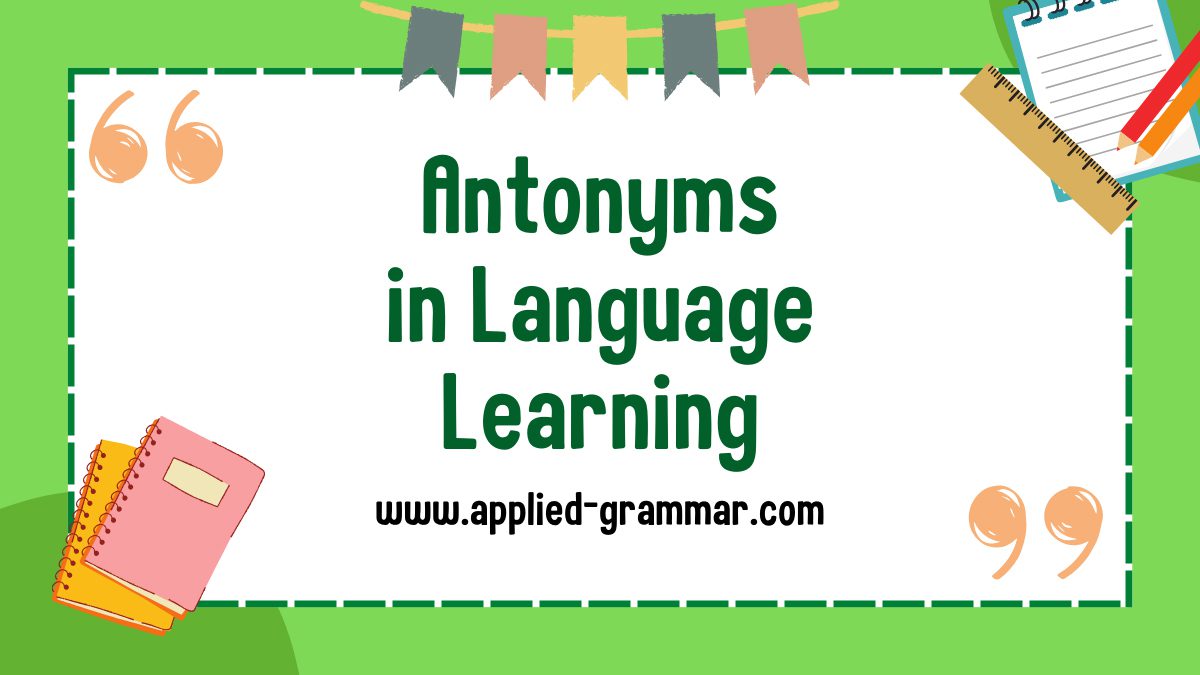Are you struggling to remember new vocabulary words in your language learning journey? Well, you’re not alone. Learning and retaining new words can be a challenge, but there are strategies that can make the process easier and more effective. One such strategy is using antonyms, or words with opposite meanings, to help you remember the meaning of unfamiliar words. In this text, we will explore how incorporating antonyms into your language learning strategies can enhance your ability to remember and understand new vocabulary words.
Research has shown that intentional instruction of vocabulary items, including the use of antonyms, is crucial for effective language learning. By actively engaging with antonyms, you can create meaningful connections between words and their opposites, which aids in memory retention. Also, repetition and multiple exposures to vocabulary items, such as antonyms, have been found to be important for long-term retention. So, by incorporating antonyms into your language learning routine, you can reinforce your understanding of words and improve your overall vocabulary acquisition.
Key Takeaways
- Antonyms are words with opposite meanings and are an important component of language learning strategies.
- Understanding antonyms can enhance vocabulary, word relationships, and overall language proficiency.
- Different types of antonyms, such as gradable, complementary, relational, and converse, contribute to a deeper understanding of words.
- Strategies for remembering antonyms include using mnemonic devices, flashcards and quizzes, and contextualizing antonyms in meaningful contexts.
- Common challenges in remembering antonyms include the similarity between opposite words and the ambiguity that can arise from different contexts.
- Overcoming these challenges can be achieved through mnemonic devices, context clues, extensive practice, and exposure to diverse texts and discussions.
What are Antonyms?

Definition of Antonyms
Antonyms are words that have opposite meanings. They are an important component of language learning strategies as they help learners understand the nuances and relationships between words. By knowing antonyms, you can expand your vocabulary and improve your ability to express yourself in a more precise and nuanced way.
Here are some key points to understand about antonyms:
- Opposite Meanings: Antonyms are words that have opposite meanings. For example, “hot” and “cold” are antonyms because they represent opposite temperatures.
- Vocabulary Enhancement: Learning antonyms can help you enhance your vocabulary. When you know the opposite of a word, it enables you to understand the word better, its usage, and its context.
- Word Relationships: Antonyms provide a way to understand the relationships between words. By learning the opposite of a word, you can grasp its meaning in a more comprehensive manner.
Types of Antonyms
There are several types of antonyms, each contributing to a deeper understanding of words. Some common types include:
- Gradable Antonyms: These antonyms exist on a continuum and represent degrees of intensity. For example, “hot” and “warm” are gradable antonyms as they represent varying degrees of temperature.
- Complementary Antonyms: Also known as binary opposites, these antonyms express mutually exclusive concepts. Examples include “alive” and “dead” or “on” and “off.”
- Relational Antonyms: These antonyms are based on a relationship or position. Examples include “above” and “below” or “teacher” and “student.”
- Converse Antonyms: These antonyms change the perspective or point of view. For example, “buy” and “sell” or “borrow” and “lend” are converse antonyms.
By understanding the different types of antonyms, you can enhance your grasp of vocabulary and improve your language skills.
Incorporating antonyms into your language learning routine can greatly benefit your overall vocabulary acquisition. Understanding the opposite meanings of words helps create meaningful connections and aids in retention. Boldly discover the area of antonyms, and watch your vocabulary expand and your language skills flourish.
Why Antonyms are Important in Language Learning
Antonyms play a crucial role in language learning strategies, particularly when it comes to enhancing vocabulary and improving memory and recall. Incorporating antonyms into your language learning routine can help you make meaningful connections between words and their opposites, leading to a deeper understanding and better retention of vocabulary. In this section, we’ll explore why antonyms are essential in language learning and how they can benefit your overall language proficiency.

Enhancing Vocabulary
Learning antonyms is an effective way to expand your vocabulary. When you encounter new words, being able to identify their antonyms helps you understand the word’s meaning in a more comprehensive manner. By learning the opposite of a word, you gain a clearer grasp of its nuances, allowing you to express yourself more precisely and accurately.
Besides, learning antonyms within a specific category or theme is advisable. Grouping antonyms together under a particular context, such as health and hospitals, helps you understand how to use them in the right context and retain a greater number of words in your memory. This focused approach allows you to deepen your vocabulary knowledge and helps you make connections between related words more easily.
Improving Memory and Recall
Repeated exposure to vocabulary items is essential for long-term retention, and antonyms provide a valuable tool in this process. When you learn a word and its opposite, you create a meaningful association between the two. This connection strengthens your memory and makes it easier to recall the word when needed.
To enhance memory and recall, it’s important to incorporate antonyms into your study plan. By dedicating specific time slots for learning antonyms and synonyms, you create a structured routine that allows for active engagement with the language. Consider using techniques like flashcards or mnemonic devices to reinforce these connections in your mind.
Plus to incorporating antonyms into your language learning routine, it’s important to create a distraction-free environment that promotes focus and concentration. Eliminate interruptions, turn off notifications on your devices, and consider using apps that block distracting websites. Taking breaks, staying hydrated, and getting enough rest will also contribute to maintaining optimal cognitive function.
Summarizing, antonyms are an essential component of language learning strategies. They enhance vocabulary, help you understand word relationships, and improve memory and recall. By incorporating antonyms into your language learning routine and creating a conducive study environment, you can effectively enhance your understanding of words and overall vocabulary acquisition.
Strategies for Remembering Antonyms

Mnemonic Devices
One effective strategy for remembering antonyms is through the use of mnemonic devices. Mnemonic devices are memory aids that help you associate and retain information. When it comes to antonyms, mnemonic devices can be especially useful in creating connections between opposite words. Here are some examples of mnemonic devices you can use:
- Acronyms: Create an acronym using the first letter of each word in the antonym pair. For example, for the antonyms “big” and “small,” you could create the acronym “BS” to easily remember the opposite meanings.
- Visualization: Imagine vivid mental images that represent the opposite meanings of the antonym pair. For instance, for the antonyms “hot” and “cold,” visualize a scorching desert for “hot” and a snow-covered mountain for “cold.”
- Association: Connect the antonyms to something you already know or have experienced. For example, for the antonyms “open” and “closed,” associate “open” with a door wide open and “closed” with a door firmly shut.
Flashcards and Quizzes
Another effective strategy for remembering antonyms is through the use of flashcards and quizzes. Flashcards allow you to review antonym pairs regularly, reinforcing the connection between the opposite meanings. Here’s how you can make the most of flashcards and quizzes:
- Create flashcards: Write the antonym pairs on separate flashcards, with one word on each side. Review the flashcards frequently, testing yourself on the opposite meanings.
- Use digital flashcard apps: If you prefer digital tools, there are various flashcard apps available that allow you to create and review antonym flashcards on your electronic devices.
- Take online quizzes: Look for online quizzes that specifically focus on antonyms. These quizzes can be a fun and interactive way to test your knowledge and improve your recall of antonym pairs.
Contextualizing Antonyms
Contextualizing antonyms involves understanding and using antonyms in meaningful contexts. This strategy helps you grasp the nuances of the opposite meanings and enhances your overall comprehension of vocabulary. Here’s how you can contextualize antonyms effectively:
- Read in context: Encounter antonym pairs in various texts, such as books, articles, and online resources. Pay attention to how antonyms are used in sentences and paragraphs, and try to infer the opposite meanings from the surrounding context.
- Write in context: Practice using antonyms in your own sentences or paragraphs. By actively using antonyms in your writing, you reinforce your understanding of their opposite meanings and improve your ability to use them accurately.
- Discuss in context: Engage in discussions or conversations where antonyms are used. Exploring the opposite meanings of words in a social setting helps solidify your understanding of antonyms and provides opportunities for further reinforcement.
Remember, incorporating mnemonic devices, flashcards and quizzes, and contextualizing antonyms into your language learning routine will greatly enhance your ability to remember and understand opposite meanings. Take the time to carry out these strategies and soon you’ll see a significant improvement in your vocabulary acquisition and retention.
Common Challenges in Remembering Antonyms

Similarity of Antonyms
When it comes to remembering antonyms, one common challenge is the similarity between opposite words. Antonyms are words that have opposite meanings, but sometimes they can appear similar or have subtle differences that make them hard to distinguish. This similarity can lead to confusion and difficulty in recalling the correct antonym in the right context. But, there are strategies you can use to overcome this challenge:
- Create mnemonic devices: Mnemonic devices are memory aids that help you associate and remember information. You can create acronyms or visualizations to connect the antonyms with their respective meanings. For example, if you want to remember the antonyms “hot” and “cold,” you can visualize a flame for “hot” and a snowflake for “cold.” This visual connection can make it easier to recall the opposite meanings.
- Use context clues: Context plays a crucial role in language learning. Pay attention to the words or phrases surrounding the antonyms in a sentence or paragraph. These context clues can provide subtle hints about the meaning of the antonyms and help you remember their opposites.
- Practice with flashcards: Flashcards are a versatile learning tool that can help reinforce your understanding and memory of antonyms. Create flashcards with pairs of antonyms and regularly review them. You can also use online flashcard apps for convenience. Test yourself by looking at one side of the flashcard and recalling the corresponding antonym. This repetitive practice strengthens your ability to remember and recall the opposite meanings.
Contextual Ambiguity
Another challenge in remembering antonyms is the ambiguity that can arise from different contexts. Antonyms can have multiple meanings depending on the context in which they are used. This variability in usage can make it challenging to associate a specific meaning with an antonym. Here are some strategies to overcome contextual ambiguity:
- Encounter antonyms in various texts: Expose yourself to different texts, such as books, articles, and online resources, that use antonyms in different contexts. By encountering antonyms in diverse settings, you develop a more comprehensive understanding of their meanings and become better equipped to discern the appropriate opposite for a given context.
- Practice using antonyms in writing: Actively incorporate antonyms into your writing practice. Write sentences or short passages that use antonyms and try to convey opposites effectively. This active engagement with antonyms helps solidify your understanding of their meanings and enhances your ability to remember and use them correctly.
- Engage in discussions: Engaging in discussions or language exchange programs with others provides opportunities to apply your knowledge of antonyms in real-time conversations. Through these interactions, you can practice using antonyms in meaningful and authentic ways, further strengthening your ability to remember and understand their opposing meanings.
Conclusion
By implementing these strategies, you can overcome the challenges of remembering antonyms in language learning. Mnemonic devices, such as acronyms and visualizations, create strong connections between opposite words and their meanings. Paying attention to context clues provides valuable hints that aid in understanding antonyms. Flashcards help reinforce your memory and understanding of antonyms. Also, encountering antonyms in various texts, practicing using them in writing, and engaging in discussions further enhance your ability to grasp opposite meanings.
Remembering antonyms is crucial for language learners as it expands vocabulary, improves comprehension, and enhances communication skills. By incorporating these strategies into your language learning routine, you will see significant improvements in your ability to remember and understand opposite meanings.
So, don’t let the similarity between opposite words or the ambiguity of different contexts discourage you. With these strategies, you can confidently navigate the world of antonyms and become a more proficient language learner. Keep practicing and incorporating these techniques, and you’ll be well on your way to mastering antonyms in no time.
